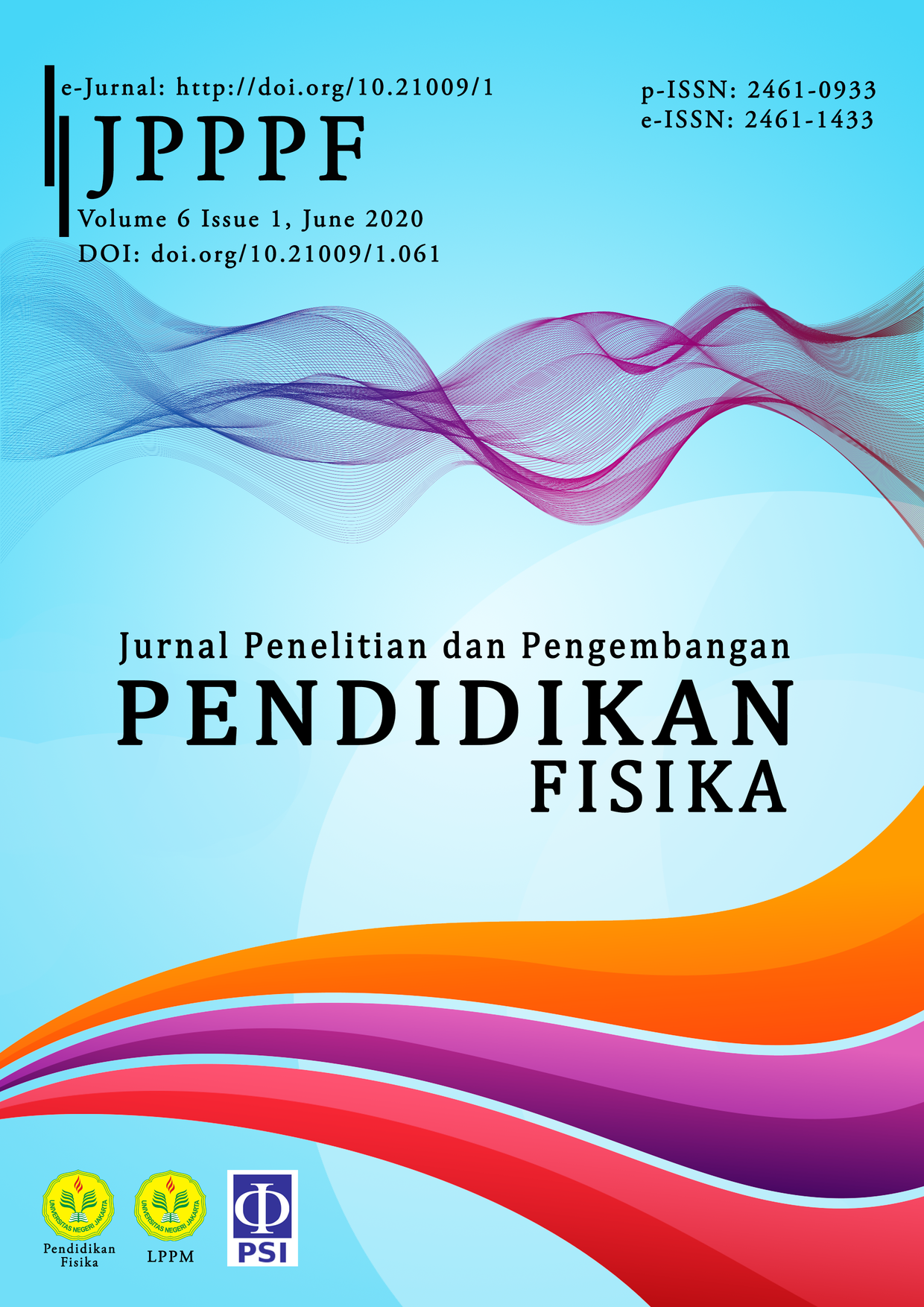The Development of Blended Learning Model using Edmodo to Train Student Critical Thinking Skills on Impulse-Momentum Topic
DOI:
https://doi.org/10.21009/1.06113Keywords:
blended learning model, critical thinking skills, edmodo, momentum and impulseAbstract
This study determines the effect of developing blended learning models using Edmodo on students’ critical thinking skills on impulse and momentum. The research method used in this study is ADDIE. The population in this study is class X MIA SMAN 4 Serang City. The sample of this study amounted to 31 students from class X MIA 2 as an experimental class using a blended learning model and 30 students from class X MIA 3 as a control class using a cooperative model. The test used in this study was seven indicators of critical thinking skills. These results indicate an increase in students’ critical thinking skills after being given treatment that is by using a blended learning model. The N-Gain value evidences a large increase in the experimental class that is 0.60 in the medium category and 0.23 in the low category in the control class. The average value of pretest and posttest is 5.27 and 9.77 in the control class, while in the experimental class is 5.65 and 16.61. These results show that there is an influence on the development of blended learning models for critical thinking skills on the momentum and impulses.
References
Allen, IE, Seaman, J, Poulin, R, & Taylor Straut, T 2016, Online report card—Tracking online education in U.S. higher education, Babson Park, MA: Babson Survey Research Group.
Arohmatul, K & Sumarni, W 2019, ‘The Effectiveness Of Blended Problem-Based Learning For Enhancing Cognitive And Learning Outcomes Of Students’ Critical Thinking Skills On Redox Materials’, Jurnal Pengajaran MIPA, vol. 24, no. 1.
Bazelais, P & Doleck, T 2018, ‘Investigating the impact of blended learning on academic performance in a first semester college physics course’, Journal of Computers in Education, vol. 5, pp. 67-94.
Bouilheres, F, et al 2020, ‘Defining student learning experience through blended learning’, Educ Inf Technol, vol. 25, pp. 3049-69.
Budi, AS, Muliyati, D, Ambarwulan, D, & Bakri, F 2019, ‘The development of ICT-based learning curriculum for pre-service physics teacher’, J. Phys.: Conf. Ser., vol. 1318, p. 012137.
Deshpande, S & Shesh, A 2021, ‘Blended Learning and Analysis of Factors Affecting the Use of ICT in Education’, Next Generation Information Processing System, pp. 311-32.
Faizah, WAA, Suparmi, S, & Aminah, NS 2019, ‘Analysis of Student Concepts Understanding in Solving Scientific Literacy on the Topic of Momentum and Impulse’, J. Phys.: Conf. Ser., vol. 1155, p. 012025.
Fariska, R & Erman, 2017, ‘Blended Learning Untuk Meningkatkan Level Kemampuan Berpikir Kritis’, Pensa E-Jurnal: Pendidikan Sains, vol. 5, no 2, pp. 60-6.
Hadisaputra, S, Ihsan, MS, Gunawan, G, & Ramdani, A 2020, ‘The development of chemistry learning devices based blended learning model to promote students’ critical thinking skills’, J. Phys.: Conf. Ser., vol. 1521, p. 042083.
Hadjarati, YA, Arota, AS, Mursalin, M, Odja, AH 2020, ‘Effectiveness of edmodo to improve senior high school students’ creative thinking skills in momentum and impulse topics’, J. Phys.: Conf. Ser., vol. 1521, p. 022065.
Malik, A, Vitriani, V, & Chusni, MM 2018, ‘Improving Students’ Critical-Thinking Skills Through Student Facilitator and Explaining Model in Momentum and Impulse Topic’, JPPPF (Jurnal Penelitian & Pengembangan Pendidikan Fisika), vol. 4, no. 2, pp. 55-64.
Murjainah, et al. 2020, ‘Improvement of students’ soft skills (honesty and motivation) using edmodo by Blended Learning Method’, IOP Conf. Ser.: Earth Environ. Sci., vol. 485, p. 012117.
Rimbawati, N & Muchlas 2015, ‘Pengembangan Model Pembelajaran Adaptive Blended Learning untuk Berbagai Jenis Gaya Belajar Siswa Menengah Atas pada Pokok Bahasan Listrik Statis’, JPPPF (Jurnal Penelitian & Pengembangan Pendidikan Fisika), vol. 1, no. 2, pp. 1-6.
Rosa, GC, Cari, C, Aminah, NS, & Handhika, J 2018, ‘Students’ understanding level and scientific literacy competencies related to momentum and impulse’, J. Phys.: Conf. Ser., vol. 1097, p. 012019.
Suryani, I 2013, ‘Keterampilan Berpikir Kritis Siswa dalam Menyelesaikan Soal Fisika tentang Impuls dan Momentum’, Jurnal Pendidikan Fisika, vol. 4, no. 2, pp. 1-8.
Tiruneh, DT, De Cock, M, Weldeslassie, AG, Elen, J, & Janssen, R 2017, ‘Measuring Critical Thinking in Physics: Development and Validation of A Critical Thinking Test in Electricity and Magnetism’, Int J of Sci and Math Educ, vol. 15, no.4, pp. 663-82.
Uzun, E 2015, ‘Students’ Attitude Towards Edmodo as a Supplementary Tool for Higher Education’, Participatory Educational Research Special Issue, pp.78-83.
Zamroni, E, Muslihati, Lasan, BB, & Hidayah, N 2020, ‘Blended Learning based on Problem Based Learning to Improve Critical Thinking Ability of Prospective Counselors’, J. Phys.: Conf. Ser., vol. 1539, p. 012039.











